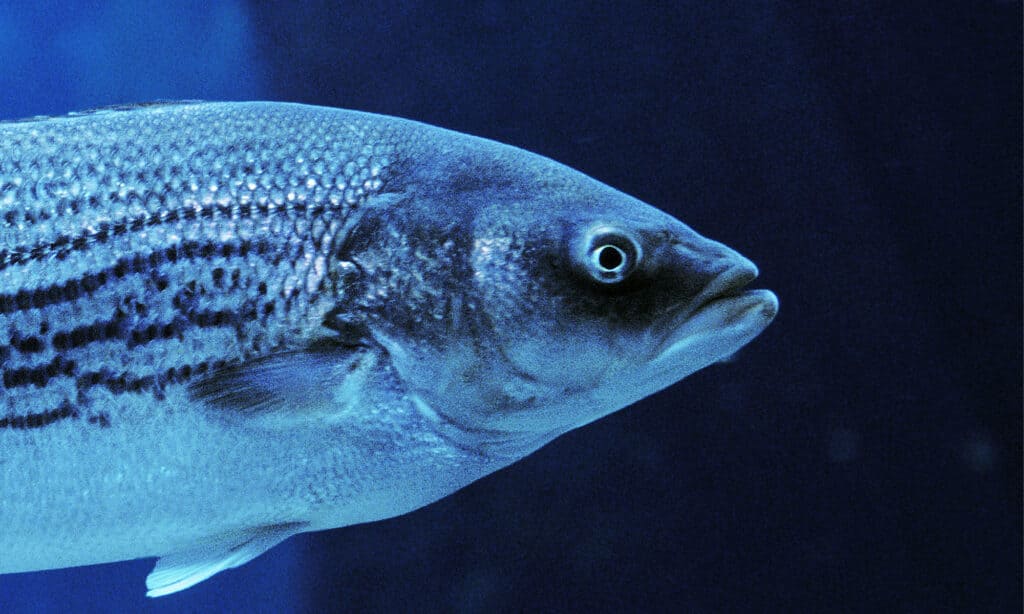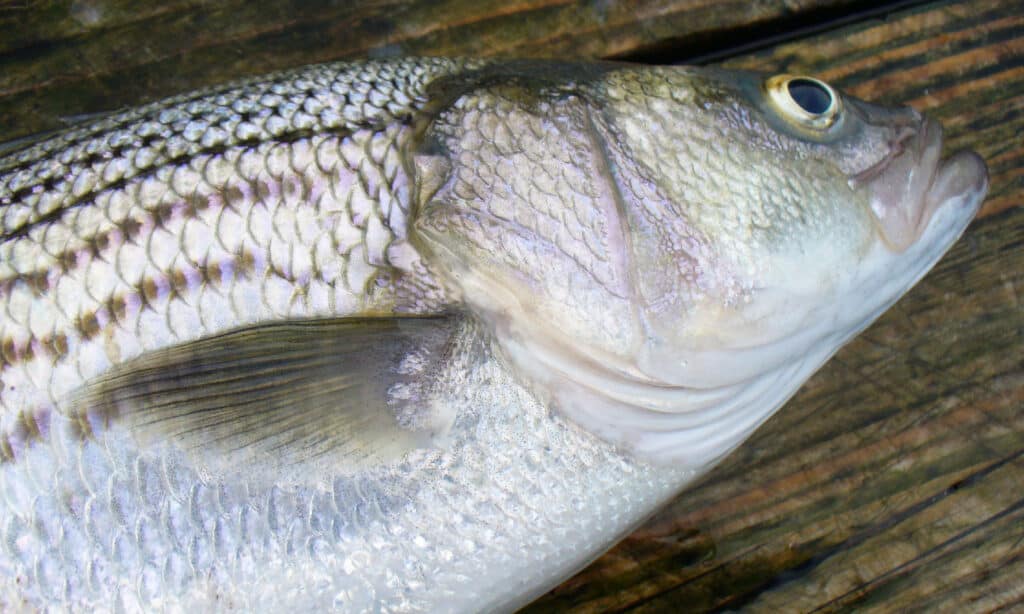While almost everyone knows about the largemouth bass for its value as sport fish, there’s a unique and less popular artificial hybrid known as the sunshine bass. Produced by crossing a female white bass with a male striped bass, this silvery striped fish is known for its strong fight and tender white meat. Hundreds of thousands of sunshine bass fingerling stocks are released into rivers and lakes in Florida and other U.S southeastern states such as Texas, Mississippi, and the Carolinas. In optimal conditions, stocked Florida sunshine bass can attain six to seven pounds in weight by the age of three. But what is the largest sunshine bass ever caught in Florida?
Background on Sunshine Bass

A striped bass is very similar to a sunshine bass.
©iStock.com/slowmotiongli
Sunshine bass is a hybrid between a female white bass and a male striped bass, produced in Florida state hatcheries. They are typically fishes with rows of irregular broken stripes on the front half of their body and continuous straight lines along the rear half – resembling white bass in body shape but have stripes like saltwater striped bass.
As for diet, an adult sunshine bass is considered a voracious feeder, eating any species of smaller fish, including threadfin and gizzard shad. A young sunshine bass begins eating insects but switches to fish as early as possible, often when it reaches 4 inches long. Young fish also consume mayflies and crustaceans. Sunshine bass fishes travel and feed in ‘schools’ (a collective term for a group of fish swimming in the same direction in a well-coordinated manner). Sunshine bass is most active during winter, with peak activity in the early morning and late evening.
Sunshine Bass in Florida
The Florida Fish and Wildlife Conservation Commission (FWC) stores sunshine bass in many states across the Southeastern United States, including Florida, Mississippi, Texas, and the Carolinas. These fish are produced and stored in Florida state hatcheries primarily for two reasons; as a gamefish and to control Gizzard Shad. Being hybrids, sunshine bass cannot breed on their own, so the Florida Fish and Wildlife stocking program releases roughly 1 million sunshine bass fishes annually into local rivers and lakes. Each year, approximately 100,000 fingerlings are released into many lakes. Sunshine bass is known for their rapid growth, which can grow to four and six pounds within three years.
The Largest Sunshine Bass Ever Caught in Florida
The largest sunshine bass ever caught in Florida was a 16.31 lbs specimen seen on Lake Seminole in 1985. Meanwhile, the world record for a sunshine bass is still the massive specimen caught in Leesville Lake, Virginia, in 1989, which weighed up to 24 pounds and 3 ounces!
Sunshine Bass VS Palmetto Bass

A striped bass is crossed with a white bass to create a sunshine bass and a palmetto bass.
©iStock.com/Coast-to-Coast
White bass (Morone chrysops) and striped bass (Morone saxatilis) are crossed to create two hybrid striped bass species; sunshine bass and palmetto bass. Sunshine bass and palmetto bass are closely related. When the eggs from female striped bass are fertilized with the sperm of white bass males, the resulting fish is called palmetto bass. Unlike sunshine bass produced by spawning sperm of male striped bass on eggs of female white bass. Sunshine and palmetto bass are nearly identical; similar in size and shape. Both hybrids appear silver and sleek, with irregular stripes on their anterior half and solid black horizontal lines on the posterior half of the body. To distinguish them, be aware that sunshine bass has a mid-body zig-zag in their stripes, while the palmetto’s stripes run uninterrupted along their body.
Best Places To Find Sunshine Bass
Sunshine bass is found throughout Florida, where they are produced and stocked. These fish are spread as far as Lake Ida in West Palm Beach. Some of the best places to fish for sunshine bass are; St. Johns, Apalachicola, and the mouth of the Escambia River. These fish are also famous for congregating in Silver Glen Springs in the Ocala National Forest in Florida, North of Orlando, during the summer.
Whether you’re an angler, an avid fisherman, or just a bystander, fishing for sunshine bass is an interesting sport. To catch them, first, you have to locate them. The best place for sunshine bass fishing is in rivers, including water outflows, spillways, and flood gates; mostly because they often seek deep lakes or feeder streams and prefer cold water conditions. They generally follow baitfish schools in the open water of large lakes, river drop-offs, and other flowing water. Because they are more attracted to some places, you will likely find them stacked in deep holes near river sandbars.
As a Game Fish
About 10 million lb (4.5 million kg) of sunshine bass are produced annually in the United States! They are stocked in dozens of large impoundments to serve as a control for baitfish populations and to provide sport for anglers. They have an aggressive feeding habit which makes them highly sought-after by anglers. Often schooling in thousands, these stocked fish surface feed on baitfish such as shad. This surface-feeding makes the fish visible and easy to catch using a wide array of lures and baits. The most effective natural baits for sunshine bass include live threadfin or other small shad and shrimp. Artificial baiting methods involve buck-tail jigs, casting spoons, inline spinners, and soft-body plastic fish replicas.
As a Food Fish
The quality of sunshine bass as food to humans closely follows their quality as a hard-fighting game or sport fish. They are a source of a delicious firm, white, flaky meat. Florida sunshines have white or light-colored flesh with a delicate flavor and delicious, firm large crispy meat. They adapt well to most recipes and are great broiled or grilled.
The photo featured at the top of this post is © iStock.com/Coast-to-Coast
Thank you for reading! Have some feedback for us? Contact the AZ Animals editorial team.






